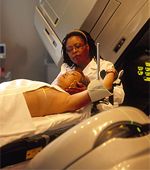Breast Cancer Study Finds More Complications and Mastectomies Associated With Brachytherapy
A study published today shows that whole-breast irradiation fares better than brachytherapy for women with breast cancer.
A study published today shows that whole-breast irradiation (WBI) fares better than brachytherapy for women with breast cancer. The authors compared complications, chances of breast preservation, and survival among a group of older Medicare breast cancer patients who received either brachytherapy or WBI.
The results, published in the Journal of the American Medical Association, suggest that brachytherapy is worse for long-term breast preservation and is associated with complications compared to WBI. No difference in survival was seen between the two techniques.[1]

Brachytherapy is a radiation technique that allows the delivery of higher and more focused radiation doses to a specific body part through an implanted radioactive source. In general, it is thought to cause fewer side effects compared to conventional radiation therapy that focuses an external beam of radiation from outside of the body. The implanted radiation technique irradiates less tissue and allows for a shorter course of treatment.
While WBI is known to increase the chance of breast preservation because it decreases the risk of local recurrence after a lumpectomy, brachytherapy is becoming more prevalent. At least 50,000 women have been treated with this newer technique including about 10% of older women with breast cancer, according to the study authors. Results from head to head, randomized comparison trials of the two radiation techniques are not yet available. These trials are years away from their readout dates. One of the major concerns, according to the authors of the current study, is that brachytherapy may not be enough to irradiate the patient’s entire tumor. This could lead to excess recurrence and therefore more surgery.
The Results
The current Medicare population cohort study analyzed data on 92,735 women with invasive breast cancer who were age 67 or older. Of these women, 6,952 had undergone brachytherapy while 85,783 were treated with WBI. Grace L. Smith, MD, PhD of the University of Texas MD Anderson Cancer Center, Houston and colleagues analyzed 5-year incidence of subsequent mastectomy. They found a 5-year cumulative incidence of 3.95% in brachytherapy patients compared with 2.18% among WBI-treated patients (P < .001). The internal radiation technique was associated with higher rates of infection-16.2% compared to 10.3% for brachytherapy compared to WBI, respectively. Postoperative complications and breast pain were also significantly higher in the brachytherapy group.
Unlike morbidities, 5-year overall survival rates were not much different among the two groups. The overall survival rate was 87.7% in patients treated with brachytherapy compared to 87.04% for patients having undergone WBI (P = .26). At the 5 year mark, an absolute 1.77% excess mastectomy risk for brachytherapy patients compared to WBI patients was found. Essentially, for every 56 women treated with a breast brachytherapy, 1 was harmed with an unnecessary mastectomy.
Brachytherapy is currently offered routinely but off-protocol in the United States. “Potential public health implications of these findings are substantial, given the high incidence of breast cancer, along with the recent rapid increase in breast brachytherapy use,” the authors state.
This study is an indication of what the randomized, long-term trials that are still ongoing may show. The results need to be validated in a younger patient population, and the patients in this cohort study should be followed for longer than 5 years. The authors caution that this current study does not prove causality between brachytherapy and a follow-up mastectomy or tumor recurrence.
Validation of these results will wait until the prospective comparison trials complete. One such trial is the RTOG 0413/NSABP B-39 trial which randomized patients to WBI or partial breast irradiation-either through brachytherapy or external beam radiation. Accrual for the trial will likely be this year, and the 3- and 5-year cumulative results are still years away. The phase III trial aims to enroll 4,300 women and has no age restriction. The primary outcome is in-breast tumor recurrence. Five-year survival and toxicities will also be analyzed.
Dr. Smith and her colleagues believe that the current Medicare results should stimulate caution in using breast brachytherapy outside of a clinical trial setting for the time being.
Reference
1. Smith GL, Xu Y, Buchholz TA, et al. Association Between Treatment With Brachytherapy vs Whole-Breast Irradiation and Subsequent Mastectomy, Complications, and Survival Among Older Women With Invasive Breast Cancer. JAMA. 2012;307:1827-1837.